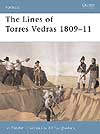Book
Review:
The Lines of Torres Vedras,
1809 - 1811
By
Ian Fletcher
Artwork by Bill Younghusband
 Torres
Vedras, the extensive defensive line that helped save Portugal
from being successfully invaded by the French, has won fame for
its almost battle-less victory.
Torres
Vedras, the extensive defensive line that helped save Portugal
from being successfully invaded by the French, has won fame for
its almost battle-less victory.
So
imposing were the works that Marshal Massena is reported to have
been so awed that he never seriously tested them and gave the
British a seemingly bloodless strategic win.
But
in The Lines of Torres Vedras, Ian Fletcher reminds us
of the fact that between 40,000 and 50,000 Portuguese died as
a result of the French blockade and the Duke of Wellington's militarily
successful scorched-earth policy.
 The
Lines of Torres Vedras is one of the Fortress series from
Osprey and will satisfy those interested in general Peninsular
War history, as well as those who like more meat to their reading.
The
Lines of Torres Vedras is one of the Fortress series from
Osprey and will satisfy those interested in general Peninsular
War history, as well as those who like more meat to their reading.
Fletcher
has tackled this complex subject and provides, in an easy-to-understand
way, everything Peninsular War buffs need to know about the fortifications.
They
were built in secret and made the most of the hills surrounding
Lisbon, which were a natural obstacle in themselves.
The
idea was seriously worked on by a Portuguese officer, Major Jose
neves Costa, and then adopted by Wellington and the British.
Most
of the works were completed by the Portuguese under the supervision
of a handful of engineering officers. One thing that surprised
me was that many of the slopes leading up to the fortifications
were blown up to make an enemy's ascent even steeper - if not
impossible.
The
main chapters within The Lines of Torres Vedras include
Design and Development, Wellington's Method of Defence, the Forts
and Life Within the Lines. There is also how the lines are today
and an excellent glossary of key engineering terms.
In
a slight departure from the usual Osprey title, the modern-day
photos of the lines far outnumber historical drawings and graphics.
In
addition The Lines of Torres Vedras includes maps showing
where the fortifcations ran, where the troops were based, cutaway
artwork of the fortifications and excellent plans of Napoleonic
forts.
This
is an important work if you want to understand just why the Lines
of Torres Vedras were so vital in the eventual victory over France.
-
Richard Moore
8/10
Osprey
Website
Osprey
PO Box 140,
Wellingborough,
Northants,
NN8 2FA,
UK.